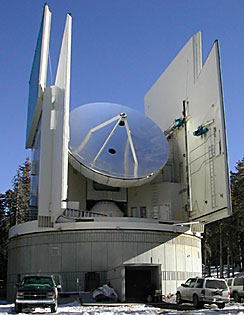 |
|
Photo courtesy Kitt Peak Observatory
|
The 10 meter Sub-Millimeter Telescope is located on Mt. Graham is one of only two of its kind in the United States, using radio waves to detect and form images.
|
|
By Rachel Williamson
Arizona Daily Wildcat
Wednesday October 9, 2002
Astronomers will be able to see into space more clearly than ever before because of work by UA researchers.
Two UA telescopes, the only two of their kind in the United States, are now networked with two European telescopes to detect images in 3,000 times more detail than what the Hubble Space Telescope can detect.
To detect an object, all four telescopes are pointed toward the same astronomical object in the sky.
Unlike traditional telescopes, these don't rely on an optical image, but detect radio wave lengths to form images.
The information recorded from each radio telescope is linked together to reconstruct an image, said Lucy Ziurys, director of the Arizona Radio Observatory.
"(The telescopes) are like very fancy radios applied to outer space," Ziurys said.
The network of telescopes can detect objects outside our galaxy, she said.
Within a 200 million billion-mile region ¸ the distance from earth to the center of the galaxy ¸ the telescope network can detect an image that is 50 million miles wide, Ziurys said.
"And that's better than anyone has done," Ziurys said.
The telescopes are also being used to detect radiation coming from other galaxies.
When more stars in a galaxy emit more radiation, that could indicate a black hole, Ziurys said.
A black hole is material so dense that sucks in everything around it, including light, she said.
Black holes emit radiation, Ziurys said.
This type of radio telescope is not easy to operate and put together, said Grahame Gay, senior engineer at Steward Observatory.
The radio receiving equipment must operate at 452 degrees below zero, Gay said. A refrigerator that generates liquid helium keeps the equipment cold.
Three other radio telescopes in the world, including one in Hawaii and one in Chile, could be added to the radio telescope network.
If this happens, an even higher resolution will produce sharper image quality, Ziurys said.
UA's telescope is one of only seven radio telescopes in the world that have the accuracy and right kind of radio wavelength to be part of the radio telescope network.

